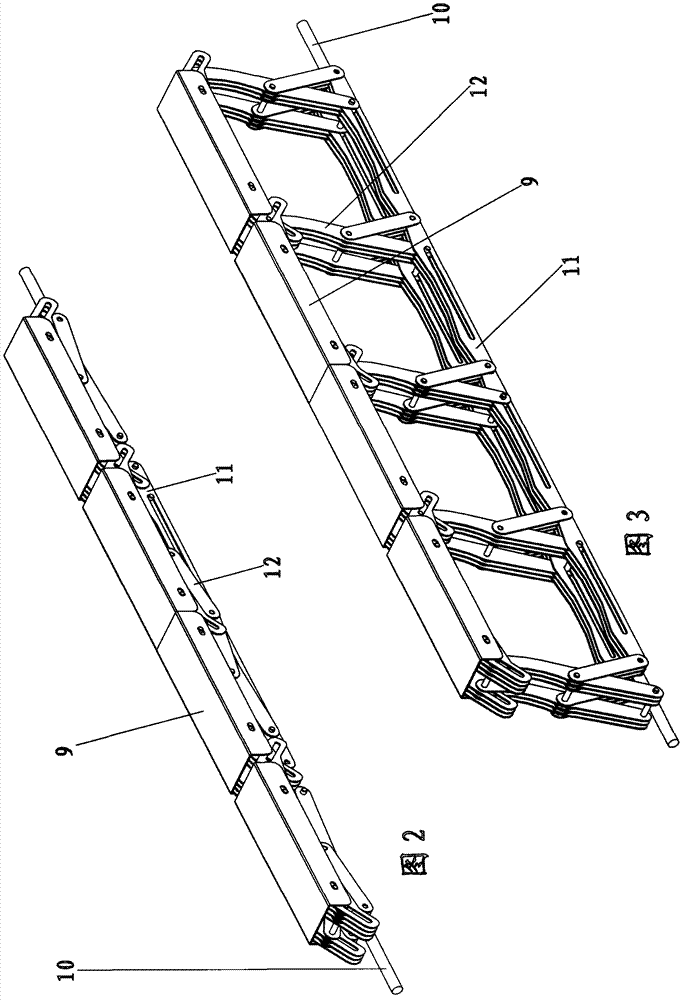Generalized urban track traffic system
An urban rail transit technology in a broad sense, applied in the field of urban transportation systems, can solve problems such as uneven quality of drivers, economic crisis in ground transportation, bad driving habits, etc., achieve timely and adjustable road functions, reduce supply and demand contradictions, and avoid charging time-consuming too long effect
- Summary
- Abstract
- Description
- Claims
- Application Information
AI Technical Summary
Problems solved by technology
Method used
Image
Examples
Embodiment 1
[0047] Embodiment 1: Basic Design Scheme of Generalized Urban Rail Transit System
[0048] figure 1 It is an overview map of the generalized urban rail transit system; the main component of the generalized rail transit system is the "generalized track", which is a special-shaped track of the category of "automatic lifting and landing net-touching movable lane barrier", consisting of multiple rows of movable rails arranged side by side. It consists of 6 rows, and the passage between the two rows of rails can only accommodate one vehicle to pass through; the figure shows three rows of rails arranged side by side, dividing the road into two lanes: the left lane 3 and the right lane 5, respectively. The vehicles on the two lanes go their own way, and they can only change lanes at the active switch in the middle.
[0049] The movable turnout includes the bottom of the fork and the front and rear transition ends of the fork, which are respectively: the rail section 4 at the bottom ...
Embodiment 2
[0059] Embodiment 2: An application example of a generalized track with a rotating display panel installed
[0060] In addition to its basic isolation and power supply functions, the generalized track can also have other additional functions, such as command and information transmission.
[0061] Figure 10 and Figure 11 is a rail row with rotatable panels; Figure 10 It is a rail row using folding panels, which is composed of three rail section units. A pair of hinged panels are installed on the top of each rail section unit. The rail segment unit 26B in the upright state and the rail segment unit 26C in the upright state. When the rail section unit is in the upright state, its two small panels are folded in half along the hinge axis and form an angle, and when the single rail section unit is in the retracted and upright state, the two small panels hinged together rotate to the same plane In this case the two panels can be used as one large panel.
[0062] Figure 11 I...
Embodiment 3
[0087] Embodiment 3: Utilize the scheme of generalized rail transit system to relieve congestion
[0088] Figure 20 and Figure 21 It is an example diagram of the application of the generalized rail transit system in terms of decongestion; traffic congestion in modern cities is due to the fact that there are too many vehicles and few roads on the one hand, and on the other hand, it is due to the lack of organization and management methods, resulting in too many vehicles on the roads and poor traffic efficiency. low.
[0089] Figure 20 It is a typical congestion phenomenon: due to the "tidal nature" of urban roads, the number of vehicles entering and leaving the city in both directions is very uneven, resulting in a situation where one side is more and the other is less; especially the peak direction road is at the exit and entrance. The passing speed of the straight-traveling vehicles behind will be affected due to the deceleration of the exiting and entering vehicles, an...
PUM
 Login to View More
Login to View More Abstract
Description
Claims
Application Information
 Login to View More
Login to View More - R&D
- Intellectual Property
- Life Sciences
- Materials
- Tech Scout
- Unparalleled Data Quality
- Higher Quality Content
- 60% Fewer Hallucinations
Browse by: Latest US Patents, China's latest patents, Technical Efficacy Thesaurus, Application Domain, Technology Topic, Popular Technical Reports.
© 2025 PatSnap. All rights reserved.Legal|Privacy policy|Modern Slavery Act Transparency Statement|Sitemap|About US| Contact US: help@patsnap.com



